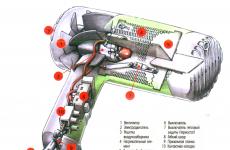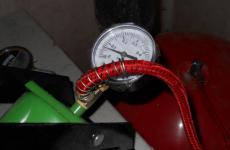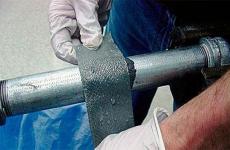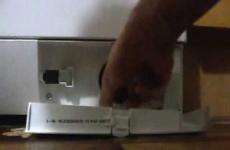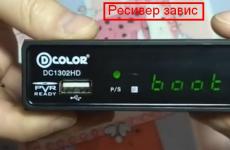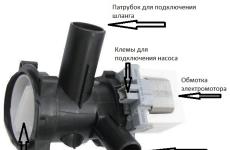Digital antenna with amplifier. Using Polish Antenna for DVB-T2
Polish antenna and digital television. The grid does not accept DVB T2, what should I do? Using a polka without an amplifier. Why the antenna does not work, possible reasons. All this and other questions in this article.
Hello dear visitors! It is no secret that the "Polish Antenna Array with Amplifier" has won wide popularity among users, and has served the people for a long time and often torments the people. Now digital DVB-T2 is replacing analog television and many people have various questions about the use of this antenna.
This is not the first article in my blog dedicated to antennas and digital terrestrial television reception. Also, I previously wrote about the use of a Polish antenna for DVB-T2, answering your questions in the comments and not much in the articles themselves. Therefore, in this article, in one place I will try to collect more complete information on the use of this type of antennas, both for analog and digital television. And it is as simple as possible, somewhere with the help of photographs, to answer questions such as:
Digital antenna
To receive digital terrestrial television DVB T2, you need a conventional UHF antenna, with or without an amplifier, it depends on the reception conditions. I will not repeat myself, more
Polish antenna for receiving digital television
The Polish antenna is broadband, i.e. capable of receiving signals of both meter and decimeter ranges. This means it is suitable for receiving DVB-T2 digital television signals. However, it is not the best option for this purpose, and some modifications are often required in order to receive a digital television signal on it. But all this is not difficult to do. About these alterations further.
What to do if the antenna array does not receive DVB T2
If you live not very far from the broadcaster of digital television signals, then the "Lattice" antenna may not receive signals at all or will receive only 10 out of a possible 20 programs. Other possible manifestations such as "freezing" of the signal, when the image freezes for a while, or the signal at times completely disappears.
In my area, and this is the Belgorod region, at a distance of 25 km from the tower of the translator, "Poles" often behave like this! What is the reason? Let's sort it out and fix it!
By default, the Polish antenna is used with an amplifier and a power supply. And if, using such an antenna with a signal, what is described above happens, it means you are in a zone of a good signal! And the amplifier is too powerful to receive the DTV signal. As a result, the signal is over-amplified.
By the way! When in manual mode, the signal level indicator on the TV screen jumps from zero to one hundred percent. Back and forth without stopping. This indicates that there is no signal or it is overpowered. Without taking action - Watching DTV is not possible!
What can you do? - You can try to reduce the power of the amplifier or remove it altogether. In the first case, you will not have to remove the antenna, and if you have a regular TV plug, you will need a screwdriver, or wire cutters and 10-15 minutes of time.
In the second case, you will need to remove the antenna, this may complicate the work somewhat, but often this is the most reliable way, ensuring the operation of the antenna without problem in many respects.
Let's go in order! What can you do without removing the antennas? Reduce amplifier power! The easiest way to lower the power of an amplifier is to lower its supply voltage. There are several ways to do this.
If you have an adjustable power supply, then there is no problem, just turn the regulator counterclockwise. In order to be able to see the result, enter the manual tuning mode through the set-top box / TV menu and enter the frequency of the channel on which the broadcast is taking place. In manual mode, a scale will display the TV signal level on the screen. This will allow you to see if the trick worked to lower the amplifier's supply voltage. By the way, you can find out which channels are broadcasting in your area.
A few more simple ways to reduce / remove the supply voltage on the amplifier.
- You can try to remove the power supply altogether, just bite the TV cable at the base of the separator with a suitable tool or disconnect it by unscrewing the screws. Next, install a regular TV plug. The one that was used with the power supply will not work, so it was removed. And when all this is done, try it like this, connect it to the console without power, sometimes it helps, but not always. It happens that without power, the amplifier does not pass the signal at all, then method number 2 is below.
- If you are using a set-top box, then you can supply power from it. To do this, we connect a TV cable with a regular plug, without a separator, to the antenna input of the set-top box, and then you need to go to the set-top box menu and find the item "Antenna power off-on". Turn on the power - This will supply 5 volts to the amplifier instead of 12. Reducing the power supply like this often helps. (in some consoles this item may be called differently)
- If you have a TV with already built-in DVB-T2 and you do not use a set-top box, then you can supply 5 volts from the USB port of the TV. To do this, you need to purchase a special adapter for powering the antenna through the TV port. (costs about 300 r)
These were the ways of altering the "Polish Antenna" for digital television, which did not require removing the antenna itself. But it also happens that even five volts is already a lot, over-amplification is in progress, and removing the power from the amplifier did not help at all.
In such a case, there will be a method described below.
Using a polish antenna without an amplifier
This method gives excellent results in an area of a good DVB-T2 signal, for example, from a TV tower in Belgorod at a distance of 25-30 km. in line of sight it catches perfectly. In addition, it immediately removes the most problematic areas of the grille antenna, amplifier and power supply. They are simply not needed. You can of course purchase a reconciliation board. But it is not always possible to find it. Therefore, we connect in a straight line - I did it repeatedly!
The only thing is that you have to get to the antenna itself in order to connect the cable as in the photo below.

As you can see, the cable is attached directly to the antenna elements. The amplifier board can be removed, but it is better to leave it, it is easier to fix the cable with it. In this case, the plug must be installed as usual.
Long antenna whiskers can be cut / broken off to the size of short whiskers, so they will work in the desired UHF range.
How to properly mount the amplifier on a grid-type antenna
It often happens that when using an amplifier, the antenna does not work, or it works, it does not work, and this applies not only to reception, but primarily analog television. The reasons can be different, but one of them is very common - it is not the correct installation of the amplifier. It would seem nothing complicated, but let's figure it out.
Here is a typical example of improper amplifier installation.

The problem is that the pads on the amplifier plate are only on one side, and in this case on top, while the antenna elements are on the bottom, under the amplifier.
This means that the amplifier contacts can connect to the loop-shaped elements of the antenna only through the bolts. In this situation, there is a high probability that the bolt will pass inside the hinge and not touch it, or barely touch it. And this means, a little oxidized and that's it. The end of the film.
But here it is correct, the loop-shaped elements are reliably pressed with nuts to the amplifier board.

The amplifier is reversed by the contacts to the loops.

This method is also correct, but at the same time it becomes unavailable to connect the cable to the amplifier, so in which case you will have to unscrew everything.
Other faults and problems with mounting this antenna
One of the malfunctions of this antenna, which few people know about, manifests itself as follows. On the TV screen, horizontal stripes float over the image, each about 5 cm wide. The reason is in the antenna power supply unit, or rather in the capacitor that stands there, it needs to be replaced. (block or capacitor) as best he can.
If the indicator in the antenna power supply goes out, this does not mean its malfunction, perhaps there is a short circuit somewhere in the cable connections. For example: at the junction, one wire protruded from the cable sheath and touched the terminal where the central core should be connected. This can happen on the amplifier side as well. Another reason for the extinguished indicator is a failed amplifier. It is easy to check this, just disconnect the power supply from the cable, and turn it on, if the indicator lights up, eliminate the short circuit.
The soldering inside the separator is often broken, look at this picture, it indicates the weak points.

Often the problem arises from a poor-quality cable connection to the separator and amplifier. For example, like this, with a bundle of protruding wires and a central core that, if you pull the cable a little, will close it with a clamp.

And here is an example of a high-quality connection and correct installation of the amplifier.

So, it is important to connect everything correctly and efficiently! How can this be achieved? Let's take a look at a separator as an example. See the photo below. We cut the cable.

P.S. If the braid is thick and sits tightly on the cable, then you can not separate it and not roll it into a bundle, but leave it on the cable and carefully cut it off, leaving only enough to clamp the fastening with a clamp, but so that it does not stick out much beyond its limits and therefore not shorted to the center wire.
And with a tourniquet we do this.



Antenna amplifier, how to choose the right one
A big mistake is made by users who want to buy the most powerful amplifier, and this is how often it happens "Give me the most powerful amplifier" they say to the seller, who want to achieve good quality TV signal and .... disappointed.
Why is this approach not correct? The fact is that an excessively strong signal is bad, this is exactly the case when the oil in the porridge may be superfluous. An excessively strong signal can lead to the opposite effect, strong interference for analog TV, for digital - cubes, stuttering and even a complete lack of picture.
The point is that along with the useful signal, various interference is amplified, moreover, often strong amplifiers have a large percentage of their own noise, which also affects the quality.
Therefore, the power of the amplifier must be selected, if you do not know which number of the amplifier is best in your area, ask your neighbors, often local sellers are aware of this too.
Amplifier parameters for TV antenna
The parameter table can help in the choice, where the approximate distances from the telecentre are also indicated, at which the use of a particular amplifier is recommended.
It is good to use a regulated power supply unit, it allows you to reduce the supply voltage of the amplifier, and thereby "stifle" excess gain.

How to protect an antenna, TV or receiver from thunderstorms
Have you ever seen a television affected by a thunderstorm? To me many times. Of course, the damage is different, but in one case there was just a burned hole in the TV chassis with a diameter of about 15 cm. But this is rather an isolated case. Nevertheless, thunderstorms are a lot of hassle. They knock out equipment, amplifiers on antennas. Is there any way to minimize or avoid damage?
Can! If you adhere to some rules.
- It is good if the antenna is grounded, in general, this is an installation requirement. Some antennas even have a welded grounding bolt near the clamp. The antenna mast (metal) must be in the ground.
- It is not always possible to organize grounding, and in such cases the amplifiers are changed quite often, almost after every thunderstorm. For the amplifier to fail, you do not need a direct lightning strike; static voltage is enough. Ground the antenna whenever possible!
- There are a number of amplifiers with built-in lightning protection, which almost never fail from static. They can be identified by obvious signs. We look at the photo.

Such an amplifier has two glass diodes, those that are circled in yellow.
This is not necessarily an amplifier with the SWA-1 number, it can be any amplifier, but if it contains such two elements, then this is an option with lightning protection. Unfortunately, such people did not come across often.
There is also an opportunity to protect your equipment from discharges, for this you need to insert a special unit into the break of the cable coming from the antenna or dish, which is called "Lightning protection"
It can be from different manufacturers, differ in appearance, but its purpose is the same: To protect the equipment from the discharges coming through the antenna cable.

It can be just such a barrel, which, using F connectors, is inserted into the cable chain, between the antenna and the TV or set-top box receiver. In which case it will fail, but not the equipment, which is much cheaper.
Of course, it will not provide one hundred percent protection, at least because the discharge can fly through the network wire. But along the antenna circuit it gives some protection.
If you really want to completely protect yourself, then in the event of a thunderstorm that is nearby, unplug all equipment from the outlet, simply turn it off with a button or from the remote control, it will not save you. And remove the antenna cable from the socket.
The same can be done with a computer, disconnect from the network and disconnect the wire through which the omniscient Internet comes.
Well, on this romantic note, I will probably end my epic about the Polish antenna.
It is not at all difficult for you, but it will be useful for the development of the site. Thanks!

